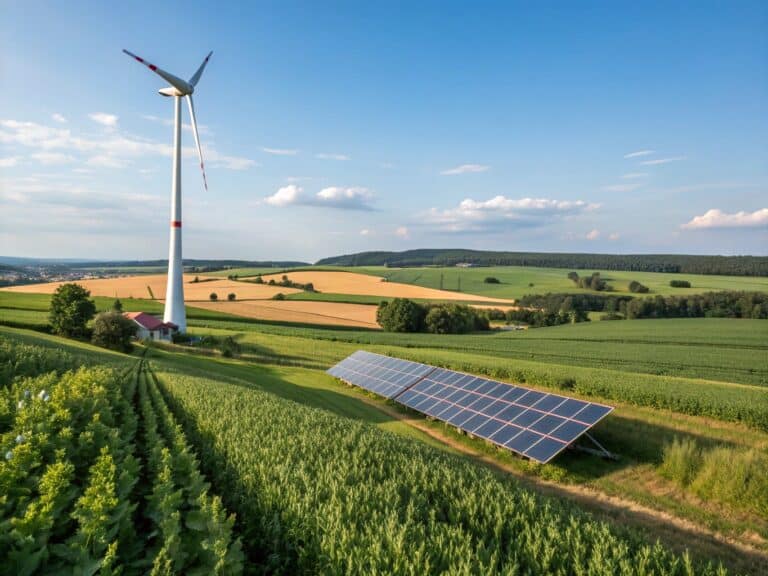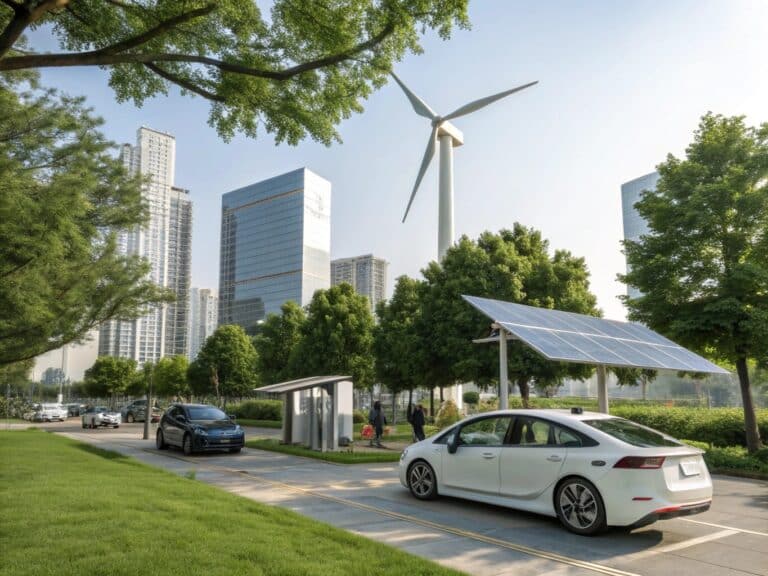How Artificial Intelligence is Building Tomorrow’s Green Economy
Artificial intelligence has come quite far from its mainstream emergence from the research labs several years ago. While generative AI models like ChatGPT and Google Gemini capture headlines for their remarkable capabilities, a parallel revolution unfolds quietly—one where AI becomes humanity’s most powerful ally against environmental destruction. PwC research indicates that GenAI could dramatically improve operational efficiency, potentially reducing carbon footprints across business processes.
The challenge lies in harnessing AI’s potential while managing its own environmental impact. This balance has sparked innovative applications across industries, from predicting natural disasters to optimizing energy grids. Here are ten groundbreaking examples of sustainable AI already transforming our world.
1. Intelligent Disaster Preparedness Systems
Revolutionary Early Warning Networks
Natural disasters devastate communities worldwide, but AI-powered prediction systems are changing the equation. Google’s Earth AI represents a breakthrough in geospatial modeling, integrating massive datasets to forecast floods, wildfires, and extreme weather events.
The platform’s AlphaEarth Foundations processes petabytes of satellite imagery, creating digital representations of terrestrial land and coastal waters. These AI embeddings now support over 50 organizations, including the United Nations, in ecosystem classification and land use monitoring.
Flood Forecasting at Global Scale
Google’s operational flood-forecasting system demonstrates AI’s life-saving potential. Built on large LSTM-based language models, the system combines hydrologic stage-forecasting with sophisticated inundation modeling to predict flood extent and depth up to seven days in advance.
Currently protecting approximately 700 million people across more than 100 countries, the system delivers real-time alerts through Google Search, Maps, and government partnerships. PwC estimates these AI-driven improvements could result in 45% of total economic gains by 2030.
Smart Forest Fire Detection
Dryad Networks has deployed approximately 400 “electronic noses” throughout Brandenburg’s Eberswalde forest, a region particularly vulnerable to wildfires. These intelligent sensors detect gases during fire’s earliest stages while monitoring temperature, humidity, and air pressure, enabling rapid response before devastation spreads.
2. Air Quality Intelligence Networks
Real-Time Pollution Monitoring
Air pollution causes over seven million premature deaths annually, generating at least $5 trillion in health damages. AI transforms this challenge through sophisticated monitoring systems that process data from multiple sources simultaneously, delivering instant alerts when pollution levels spike.
Applications like IQAir provide real-time pollution rankings for cities worldwide, while Plume Labs creates comprehensive pollution maps with hourly forecasts. These systems empower individuals to make informed decisions about outdoor activities and health protection.
Predictive Air Quality Models
Cornell engineers developed AI models capable of calculating fine particulate matter (PM2.5) concentrations—the dangerous soot, dust, and vehicle exhaust that penetrates human lungs. These predictive systems enable proactive measures, potentially preventing thousands of pollution-related health incidents.
3. Biodiversity Conservation Technology
Wildlife populations face unprecedented threats from climate change, but AI offers new hope. Wildbook utilizes neural networks and computer vision algorithms to identify and count animals in photographs, enabling precise population estimates for species ranging from birds to cetaceans.
This technology provides researchers with:
- Enhanced habitat analysis capabilities
- Accurate wildlife population assessments
- Real-time climate impact monitoring on animal populations
The system’s ability to identify individual animals within groups revolutionizes conservation efforts, providing data previously impossible to collect at scale.
4. Business Sustainability Analytics
Document Analysis for Waste Reduction
Large language models excel at analyzing business documents to identify sustainability opportunities. AI algorithms can optimize supply chain processes by detecting inefficiencies and suggesting fuel consumption reductions, directly cutting greenhouse gas emissions and resource consumption.
These systems help companies calculate accurate carbon footprints at reduced costs by analyzing transportation, energy use, and resource consumption data across entire operations.
Supply Chain Risk Assessment
AI tools like ChatGPT enable companies to identify Scope 3 greenhouse gas emissions—those generated indirectly through supply chains and product lifecycles. By analyzing news articles, industry reports, and social media posts, businesses can proactively address environmental risks and align with sustainability principles.
5. Climate Simulation Revolution
NVIDIA’s Earth-2 represents a quantum leap in climate modeling. This GPU-accelerated platform enables kilometer-scale global modeling with unprecedented efficiency. The system’s generative AI model, cBottle (“Climate in a Bottle”), generates global atmospheric states with 1-2 kilometer resolution while dramatically reducing computation time and energy use.
Key achievements include:
- Data compression ratios up to 3,000× per sample
- Forecast speeds thousands of times faster than traditional methods
- Up to 10,000× more energy-efficient than conventional approaches
- Integration with leading research institutions for interactive climate exploration
6. Smart Agriculture Revolution
Autonomous Agricultural Robotics
AI-powered robots navigate farmland with self-driving car precision, harvesting crops at optimal maturity. This technology reduces waste while improving production efficiency, enabling farmers to maximize yields with minimal environmental impact.
Precision Weather Forecasting
Agricultural AI systems provide location-specific weather predictions, helping farmers optimize watering schedules and determine ideal planting and harvesting times. This precision reduces water waste and chemical usage while maximizing crop productivity.
Intelligent Land Management
Satellite imagery combined with AI algorithms enables sophisticated farmland planning. Farmers can determine optimal planting locations and timing while ensuring regulatory compliance, leading to more sustainable land use practices.
Crop and Livestock Health Monitoring
AI-powered image recognition and sensor networks detect early signs of crop diseases and animal health issues. This early intervention capability reduces the need for excessive chemicals and medicines, preventing losses while minimizing environmental impact.
7. Manufacturing Quality Intelligence
Computer vision systems revolutionize quality control by detecting product defects more accurately than manual inspection. These AI-enabled systems, installed on production lines, significantly reduce defective products, ultimately decreasing product returns and associated greenhouse gas emissions from reverse logistics.
The technology’s precision minimizes waste while improving overall manufacturing efficiency, contributing to more sustainable production processes.
8. Environmental Leak Detection Systems
AI-powered computer vision detects water leaks and harmful chemical releases within production facilities, alerting authorities for immediate action. These systems help businesses dramatically reduce their environmental impact through rapid response to potential contamination events.
Advanced monitoring capabilities enable remote site supervision, achieving safer, more accurate, and cost-effective environmental protection than traditional methods.
9. Workplace Safety Enhancement
Sustainability encompasses environmental, social, and governmental dimensions. AI-enabled computer vision systems improve worker safety by ensuring compliance with safety regulations, enhancing businesses’ social sustainability.
Smart cameras installed throughout manufacturing facilities monitor safety equipment usage and identify potential risks, notifying safety managers for immediate intervention. This technology creates safer work environments while supporting comprehensive sustainability goals.
10. Energy Optimization Networks
Despite significant renewable energy investments, renewable sources account for only 30% of global electricity generation. [15] AI addresses this challenge by analyzing energy consumption patterns and providing insights for reducing usage without compromising productivity.
Renewable Energy Integration
AI systems help optimize energy usage in data centers through improved cooling systems and power usage effectiveness (PUE). These technologies predict and manage energy storage needs, aligning renewable energy generation with demand patterns.
Sustainable Logistics Solutions
AI-powered software optimizes delivery routes by incorporating sustainability as a primary factor. Route optimization provides significant financial and environmental benefits, with digital twin technologies enabling sustainable last-mile delivery solutions.
These systems account for a substantial portion of corporate carbon footprints, making optimization crucial for achieving sustainability goals.
The Path Forward: Balancing Innovation with Responsibility
While these applications demonstrate AI’s tremendous potential for environmental good, the technology itself presents sustainability challenges. Advanced AI models require significant computing power, potentially consuming substantial energy.
The solution lies in developing energy-efficient AI systems powered by renewable energy sources while maintaining focus on applications that deliver measurable environmental benefits. Companies must implement ethical guidelines ensuring AI development serves both technological advancement and planetary preservation.
By strategically deploying AI across these ten domains, organizations can harness technology’s power to create a more sustainable future while managing the environmental implications of AI development itself.
If you are interested in this topic, we suggest you check our articles:
- AI-Powered Search Evolves with Reddit Answers
- Avoid This When Entering Prompts for AI Search Tools
- Perplexity’s Challenge to Google’s Search Dominance
- Where Search LLMs Crawl Their Data?
- The Impact of AI Overviews on Search and Website Engagement
Sources: AIMultiple, Datacamp, Nvidia, United Nations, Euronews, Google
Written by Alius Noreika


